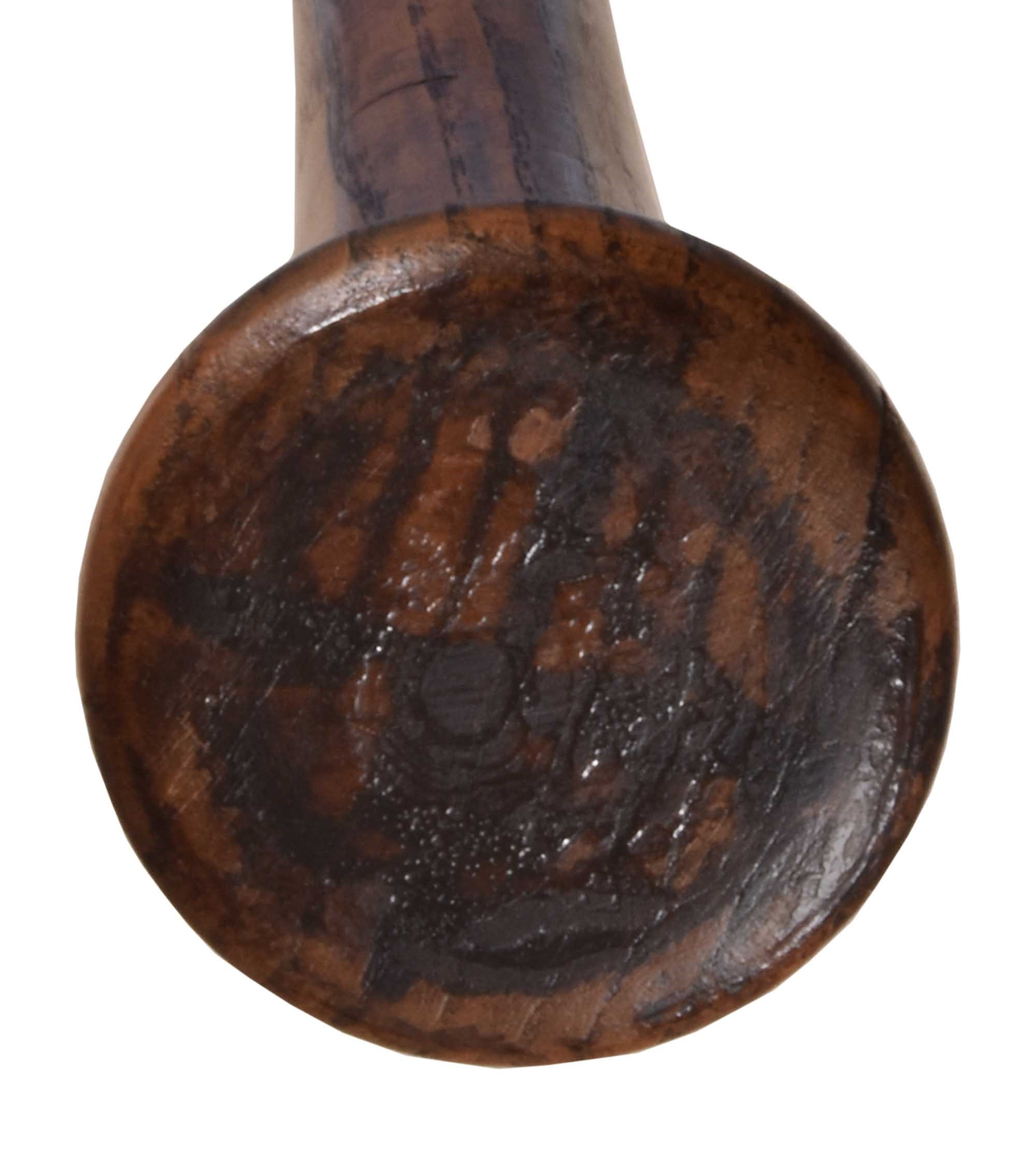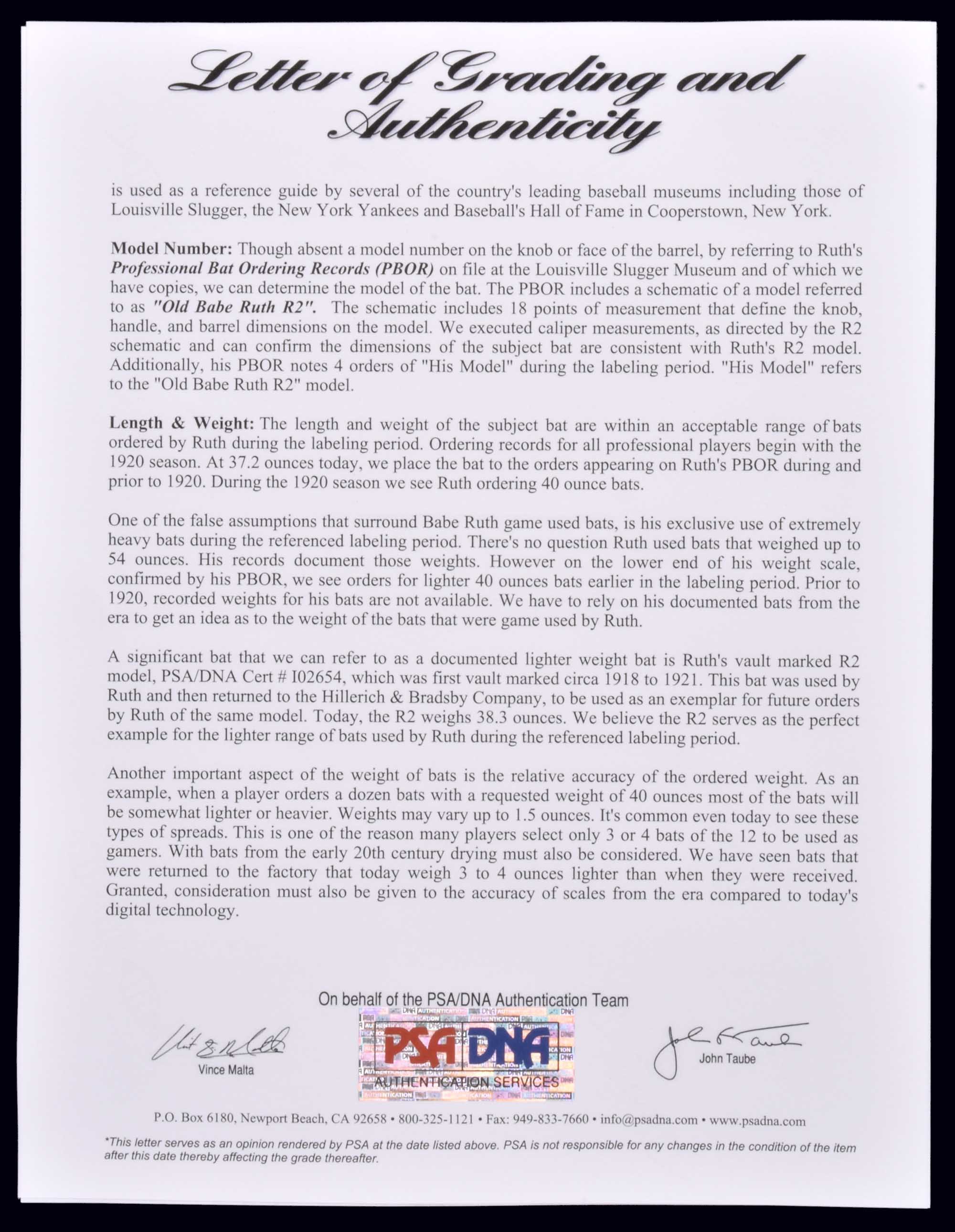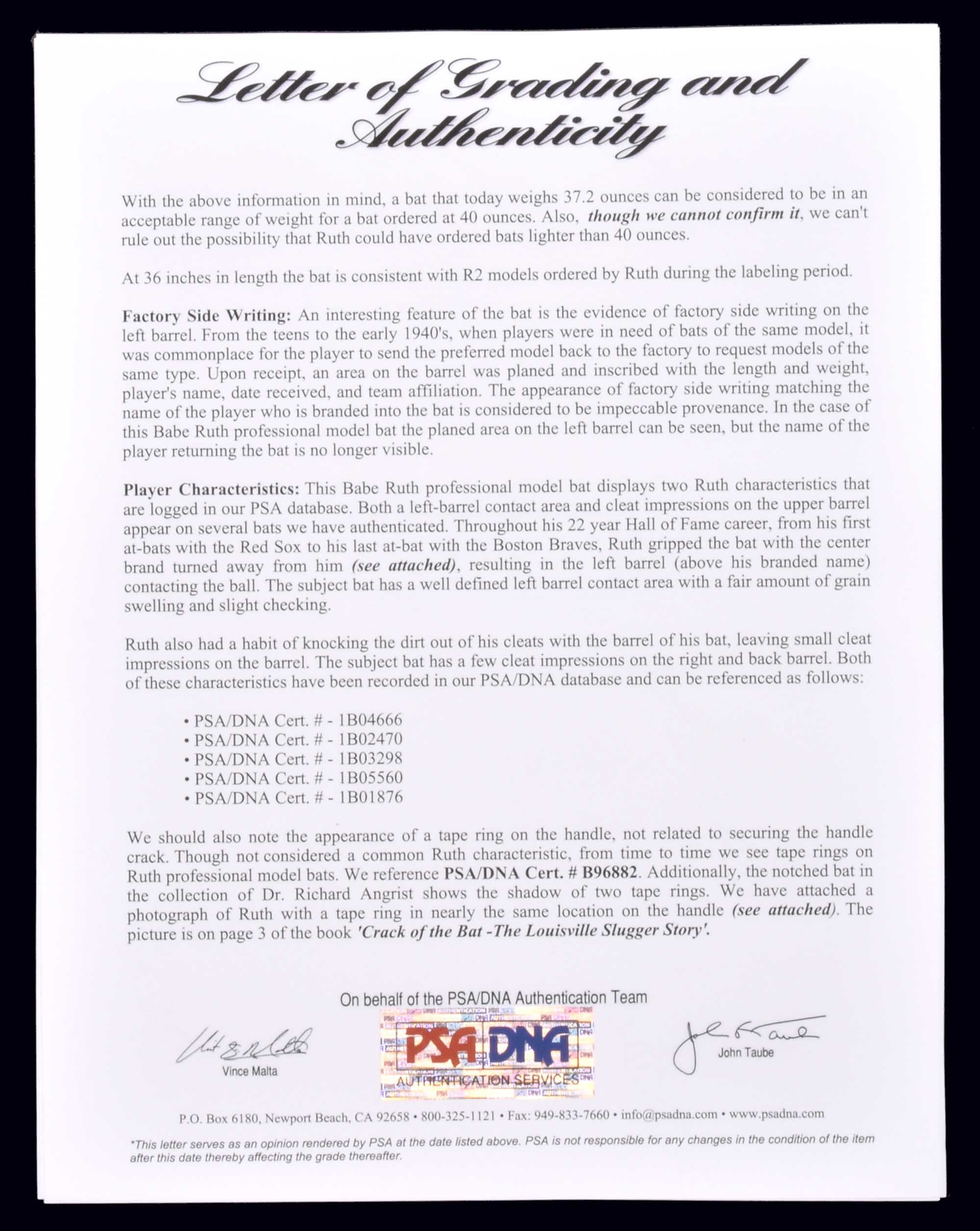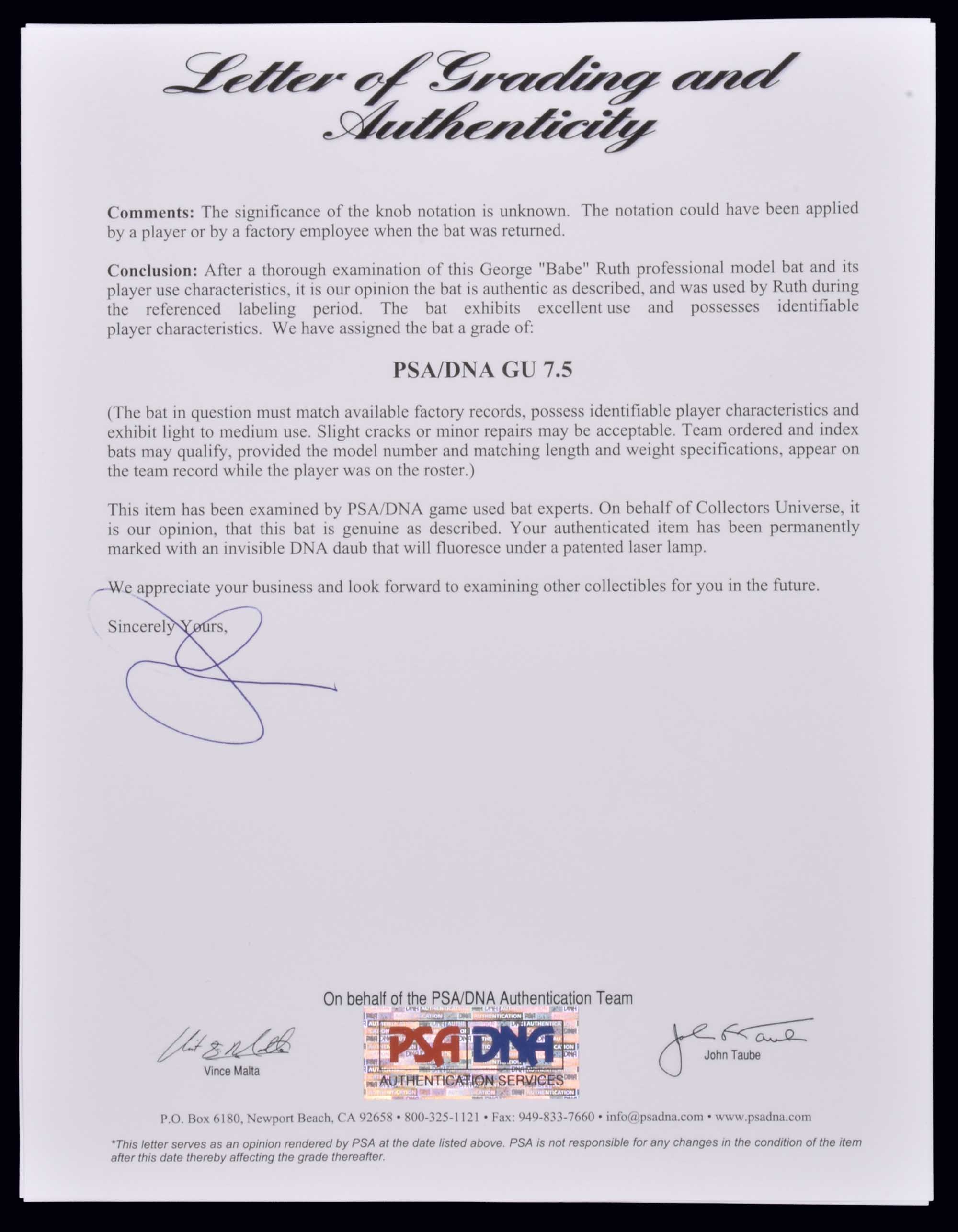Search
1918-1922 Babe Ruth Game-Used Bat PSA/DNA GU 7.5
Sold For:
$66,000
Year: 1918
Auction: 2018 Fall
Lot #: 6
Auction: Post-1900 Baseball Memorabilia
Babe Ruth H&B game-used signature-model (predating model numbers) bat dating from the 1918 to 1922 manufacturing period. Graded GU 7.5 by PSA/DNA. This is an outstanding Babe Ruth game used bat, which, as PSA/DNA explains in its accompanying LOA, most likely dates from the earlier portion of the referenced manufacturing period. The bat, which measures 36 inches in length and weighs 37.4 ounces, displays evidence of excellent use along its entire length, including numerous ball marks on the left barrel, cleat marks on the front and back barrel, slight checking (grain separation) on the left and back barrel, and an approximate eight-inch crack in the upper handle. Also evident on the handle is the shadow of a single tap ring. An "X" or black cross (meaning unknown) is marked on the end of the knob.
In addition to its use, the bat also displays evidence of factory side writing. When players returned bats to the H&B factory (to be used as templates for future orders), identifying notations, including the player's name and date received, would be written in grease pencil on a slightly planed side of the bat by an H&B employee. The bat was then stored in the vaults for future reference. In that regard, a side-written name that matches the name of the player stamped on the barrel is recognized by sophisticated collectors as being the equivalent of having a letter of authenticity directly from the player himself. On the offered bat, the area of planing can be seen on the left side of the barrel, but the information regarding the player who returned the bat has faded beyond legibility.
Based upon available factory records, PSA/DNA believes this bat is most consistent with Ruth bats dating from the earlier portion of the labeling period: "The length and weight of the subject bat are within an acceptable range of bats ordered by Ruth during the labeling period. Ordering records for all professional players begin with the 1920 season. At 37.4 ounces today, we place the bat to the orders appearing on Ruth's PBOR during and prior to 1920." PSA/DNA also notes that the bat features two known Ruth characteristics:
This Babe Ruth professional model bat displays two Ruth characteristics that are logged in our PSA database. Both a left-barrel contact area and cleat impressions on the upper barrel appear on several bats we have authenticated. Throughout his 22 year Hall of Fame career, from his first at-bats with the Red Sox to his last at-bat with the Boston Braves, Ruth gripped the bat with the center brand turned away from him resulting in the left barrel (above his branded name) contacting the ball. The subject bat has a well defined left barrel contact area with a fair amount of grain swelling and slight checking. Ruth also had a habit of knocking the dirt out of his cleats with the barrel of his bat, leaving small cleat impressions on the barrel. The subject bat has a few cleat impressions on the right and back barrel.
If PSA/DNA is correct, and this bat does date to the earlier half of the referenced labeling period, it was used by Ruth during his transition from full-time pitcher to everyday outfielder. In 1918, Boston Red Sox manager Ed Barrow decided that as valuable as Ruth was on the mound, he was even more valuable to the club as a hitter. That season, Ruth started only 19 games on the mound, which was half his total from the year before, and began to play more regularly in the outfield. Barrow's decision proved to be the right one, as Ruth batted .300 with a league-leading 11 home runs and 61 RBI in just 95 games. The following season he fully emerged as the greatest power hitter in the game by hitting a then-record 29 home runs while driving in a league-leading 113 runs. Following that incredible season, Red Sox owner Harry Frazee stunned the Boston faithful by selling Ruth's contract to the New York Yankees for over $400,000 in cash and credit, which was twice the amount previously paid for a player's contract. This is both an early and significant Ruth bat dating from his final years in Boston and the birth of the New York Yankees baseball dynasty. LOA from John Taube of PSA/DNA. Reserve $25,000. Estimate (open).
In addition to its use, the bat also displays evidence of factory side writing. When players returned bats to the H&B factory (to be used as templates for future orders), identifying notations, including the player's name and date received, would be written in grease pencil on a slightly planed side of the bat by an H&B employee. The bat was then stored in the vaults for future reference. In that regard, a side-written name that matches the name of the player stamped on the barrel is recognized by sophisticated collectors as being the equivalent of having a letter of authenticity directly from the player himself. On the offered bat, the area of planing can be seen on the left side of the barrel, but the information regarding the player who returned the bat has faded beyond legibility.
Based upon available factory records, PSA/DNA believes this bat is most consistent with Ruth bats dating from the earlier portion of the labeling period: "The length and weight of the subject bat are within an acceptable range of bats ordered by Ruth during the labeling period. Ordering records for all professional players begin with the 1920 season. At 37.4 ounces today, we place the bat to the orders appearing on Ruth's PBOR during and prior to 1920." PSA/DNA also notes that the bat features two known Ruth characteristics:
This Babe Ruth professional model bat displays two Ruth characteristics that are logged in our PSA database. Both a left-barrel contact area and cleat impressions on the upper barrel appear on several bats we have authenticated. Throughout his 22 year Hall of Fame career, from his first at-bats with the Red Sox to his last at-bat with the Boston Braves, Ruth gripped the bat with the center brand turned away from him resulting in the left barrel (above his branded name) contacting the ball. The subject bat has a well defined left barrel contact area with a fair amount of grain swelling and slight checking. Ruth also had a habit of knocking the dirt out of his cleats with the barrel of his bat, leaving small cleat impressions on the barrel. The subject bat has a few cleat impressions on the right and back barrel.
If PSA/DNA is correct, and this bat does date to the earlier half of the referenced labeling period, it was used by Ruth during his transition from full-time pitcher to everyday outfielder. In 1918, Boston Red Sox manager Ed Barrow decided that as valuable as Ruth was on the mound, he was even more valuable to the club as a hitter. That season, Ruth started only 19 games on the mound, which was half his total from the year before, and began to play more regularly in the outfield. Barrow's decision proved to be the right one, as Ruth batted .300 with a league-leading 11 home runs and 61 RBI in just 95 games. The following season he fully emerged as the greatest power hitter in the game by hitting a then-record 29 home runs while driving in a league-leading 113 runs. Following that incredible season, Red Sox owner Harry Frazee stunned the Boston faithful by selling Ruth's contract to the New York Yankees for over $400,000 in cash and credit, which was twice the amount previously paid for a player's contract. This is both an early and significant Ruth bat dating from his final years in Boston and the birth of the New York Yankees baseball dynasty. LOA from John Taube of PSA/DNA. Reserve $25,000. Estimate (open).
